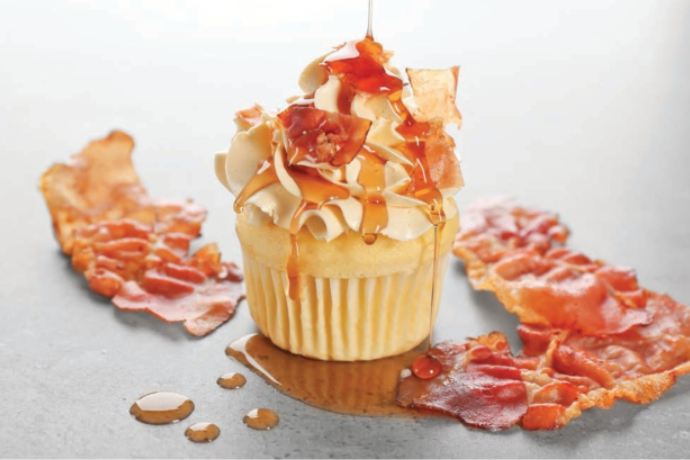Bacon is not just a breakfast item anymore. The salty, smoky, savory, sweet treat is officially a staple on lunch and dinner menus while transcending many other food groups as a flavor profile or ingredient. It is even a grab-and-go snack item thanks to Dunkin’s new product, Snackin Bacon.
Bacon production is surging ahead and so are retail sales. Based on marketing research from IRI, US sales were $4.93 billion in the 52 weeks ending Feb. 23, 2020 – a 2.1% increase from this time last year. Overall sales of bacon are up 14¢ per unit from this time last year. Private label bacon is leading the charge with sales topping $1.22 million, a 6% increase from a year ago. Hormel Foods Corp. and Tyson Foods Inc.’s Wright Brand Foods are also both up over 6% in sales from last year, according to IRI research.
Time for bacon
Bacon is now consumed at all hours of the day and at every meal. Research from the National Pork Board (NPB), Des Moines, Iowa, shows that bacon is found in 70% of restaurants nationwide.
It is used to complement mainstay dishes and in some non-traditional ways. Barbecue restaurants and smokehouses are offering thick-cut slab bacon as one protein choice, for example. Bacon is being used in all types of preparations from salads to macaroni and cheese. There are bacon jams, cupcakes sprinkled with bacon and even bacon milkshakes.
Consumers are continually drawn to hardwood smoked bacon, like applewood and cherrywood, or bellies cured with maple syrup, said Tara Dugan, director of consumer and marketplace insights for the NPB.
Producers are learning to market bacon not just as an indulgent luxurious breakfast food. They are adapting to healthier-eating trends and making a product that gives bacon-eaters peace of mind.
“What we found is that bacon is one of those categories that people want to indulge in,” Dugan said. “There is growth in certain claims – references to nitrate-free, organic, and all-natural. For regular consumers who are eating it quite often, they want some of those claims so they feel better about it.”
In the last four years, the foodservice sector has seen a rise in production claims of all-natural (up 149%), nitrate-free (up 99%) and organic (up 99%), according to the NPB.
John Hernandez, Hormel’s breakfast meats brand manager, said its Applegate Natural brand is seeing a lot of success. IRI shows a 6.2% increase in sales per unit of Applegate bacon compared to this time last year. In order to meet consumers where their needs are, Hormel is increasing its antibiotic-free category to keep up with the double-digit growth, Hernandez said. Consumers are also demanding more convenience in how they get their bacon. Hormel has seen a lot of growth in its microwave-ready Black Label bacon that offers families a faster and not-as-messy way to enjoy bacon.
“There’s a ton of passion around bacon in terms of what it does for people not only spiritually and physically, but it’s also emotional,” Hernandez said. “It’s one of the few foods where children will actually put down the iPad to run over and grab a slice of bacon while you’re cooking it.”
Bacon continues to be the favored pork product. The NPB reports that 80% of American households are bacon buyers.
High on the hogs
David P. Anderson, PhD, professor at the department of agricultural economics at Texas A&M University, noted that pig farmers are producing record numbers. For most of the first two months of the year, almost 200,000 more hogs were being processed this year compared to last.
According to the US Department of Agriculture, first-quarter hog prices are expected to be about 8% above year-ago levels. Anderson points to the export market fueling this continued rise in price and production, but that is not to say that Americans are buying less pork belly and bacon.
American consumers have increasingly shown an interest in pork loin cuts. This has driven hog farmers to grow leaner animals to cater to what the market is asking for. This focus on genetics has led to more interest in heritage breeds – like Berkshires – because the marbling of fat and meat is more pronounced, Anderson said.
This is a good thing for the bellies and the bacon.
“Customers are definitely looking for those meatier slices (of bacon),” Hernandez said. “One great alternative is center-cut bacon.”
For bacon lovers, it all comes down to flavor. Center-cut bacon comes from the middle of the belly where there is slightly less fat and more muscle. Many brands are finding that consumers like the thicker cuts of bacon because they cook up crispy on the outside but stay juicy in the middle. Thinner strips are great for wrapping steaks, scallops, or jalapeño poppers.
“If you ask anyone on the street if they like bacon: they say ‘yes,’” Anderson said.


